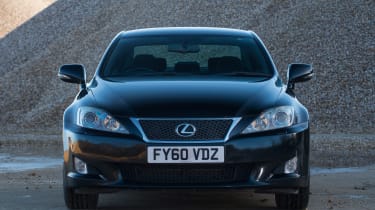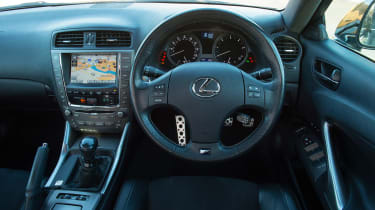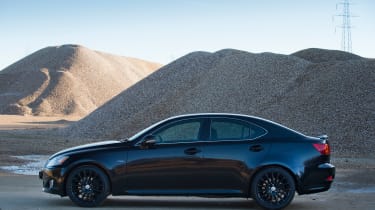Used Lexus IS review
A full used buyer’s guide on the Lexus IS covering the Mk2 IS (2005-2013) and the Mk3 IS (2013-date)
2019 will mark the 30th anniversary of Toyota introducing the Lexus brand. Its first car was the LS 400, a model that offered the latest tech, plus incredible reliability and astonishing refinement, but little driver appeal.
Since then Lexus has launched a raft of other models, including the IS in the compact executive segment. The first generation came with petrol power only, but bowing to market forces the second version had a diesel engine, too.
As a budget luxury small family car there’s plenty to like about the IS Mk2, especially the keen prices. But there’s also plenty to watch out for, which is unsurprising given that many of these cars are now around a decade old.
Models covered
- • Lexus IS Mk2 (2005-2013) - Compact exec is a sensible pick, but it’s not as polished to drive as rivals.
- • Lexus IS Mk3 (2013-date) - Classy looks and strong reliability make Mk3 compact exec a fine used buy.
Lexus IS Mk2
History
The IS Mk2 arrived in November 2005, in 2.5-litre petrol (IS 250) saloon form with a choice of standard, SE, SE-L or Sport trims. The first ever diesel-engined Lexus appeared five months later; the IS 220d. In April 2008 the Japanese brand created a BMW M3 rival with its 417bhp 5.0-litre V8-powered IS-F.
Used - available now

2023 Mercedes
EQC
25,247 milesAutomaticElectric
Cash £23,597
2024 Volkswagen
Passat GTE Estate
47,534 milesAutomaticPetrol1.4L
Cash £19,697
2021 Audi
Q3
55,755 milesAutomaticPetrol2.0L
Cash £20,197
2023 Tesla
New Model Y
20,490 milesAutomaticElectric
Cash £26,697A facelift in November 2008 (for all but the IS-F) brought a revised nose, an overhauled dash and a new SE-I trim between SE and SE-L specs. The IS 250C coupé-cabriolet hit showrooms in July 2009, in 2.5-litre petrol form only.
From December 2009 there was a new HDD nav system and an F-Sport trim. The IS 200d replaced the IS 220d in August 2010 and the IS 250 went auto-only.
Leuxs IS Mk2 reviews
Lexus IS 200d reviewLexus IS 250c reviewLexus IS-F review
Which one should I buy?
The IS 250 is thirsty but nicer to drive than the diesels, plus it’s more refined. And although it was initially offered as a manual, virtually all IS 250s are autos.
The diesels came in manual form only and while these are frugal, they’re not as refined as you’d expect a Lexus to be and the manual box is poor. All ISs are well equipped; standard across the range are eight airbags, cruise control, a 13-speaker stereo, climate control plus alloy wheels. SE models add leather trim, heated and ventilated seats, automatic wipers, xenon lights, front and rear parking sensors and an electrically adjustable steering column.
Sport features suede-effect seat trim, 18-inch rims and lowered suspension.
Alternatives to the Lexus IS Mk2
BMW’s 3 Series is the most desirable IS rival thanks to its wide array of engines and bodystyles. Build quality is generally superb and the 3 Series is also renowned for its sharp dynamics.
A slightly cheaper rival is Audi’s A4, which is available with some brilliant petrol and diesel engines, along with four-wheel drive, which is why the German model makes a superb tow car.
The Mercedes C-Class is another premium family car that’s plentiful and comes in numerous guises, but running costs can be high. Unlike the Lexus, all of these German rivals come in saloon or estate forms. But don’t overlook the Mazda 6 which is great to drive, looks sharp and is well equipped, too.
What to look for:
Wheels
Alloys are prone to lacquer bubbling and blistering, as well as corrosion, especially if they’re not cleaned regularly.
Steering
Power steering can be unreliable, so make sure there’s a consistent feel as you turn the wheel; check for leaks too.
Engine
IS 220ds built before the November 2008 facelift can suffer from turbo lag and a lack of power below 2,000rpm.
Trim
Interior trim isn’t always as well screwed together as you’d hope; listen out for door panel and dash rattles.
Interior
Front-seat occupants will be comfortable, but those in the back don’t get much head or legroom. Build quality is generally good with plenty of premium materials, but the over-fussy design can make the dash hard to use. Boot space also isn’t very good, at just 378 litres; the contemporary 3 Series could accommodate 460 litres of luggage.
Running costs
All cars need checking every 10,000 miles or 12 months. Services alternate between minor and major. These cost £225 and £345 respectively for diesels, £275 and £445 for the IS 250 and £295 or £495 for the IS-F.
Each derivative has a more expensive full service when more work is needed. For the diesels this comes at 100,000 miles (£545), while it’s every 60,000 miles for the IS 250 (£645) and IS-F (£745).
All engines are chain-driven, so cambelts don’t need replacing. Brake fluid should be changed biannually and the coolant after 100,000 miles or 10 years (then every 60,000 miles). This is included in the costs given.
Recalls
Six recalls isn’t a disaster. The first came in July 2006 and affected just 11 cars with faulty airbags. A recall in April 2008 focused on possible fuel leaks, with brake fluid leaks prompting another in November 2010.
Fuel leaks were behind an IS 250 campaign issued in February 2011, while faulty IS 250 wipers were fixed in April 2013. In November 2014 petrol-engined ISs were recalled because of potential fuel leaks.
Driver Power owner satisfaction
The IS Mk2 last appeared in a Driver Power survey in 2016, when it came 85th; the highest score it ever achieved was 18th in 2009. In-car tech, seat comfort and build quality were the stars of the show, while running costs and practicality were the sticking points. Ride quality and ease of driving were ranked mid-table.
Verdict
For many the IS would appear to be the perfect car; ergonomically sound, well equipped, comfortable and very good value thanks to some low prices. The IS is also pretty reliable, but the narrow model range means you have to choose between a thirsty petrol engine or a noisy diesel. In its home market the IS was sold as a Toyota, and in some ways the model is more deserving of that badge than the Lexus one. The dynamics aren’t as polished as some of its rivals’, but as an ownership experience any Lexus is usually hard to beat; the company’s dealer network offers unrivalled levels of service. So while driving an IS probably won’t set your pulse racing, neither will the prospect of running one.
Click through to page two for our full buyer’s guide on the Lexus IS Mk3 sold from 2013 to date…












